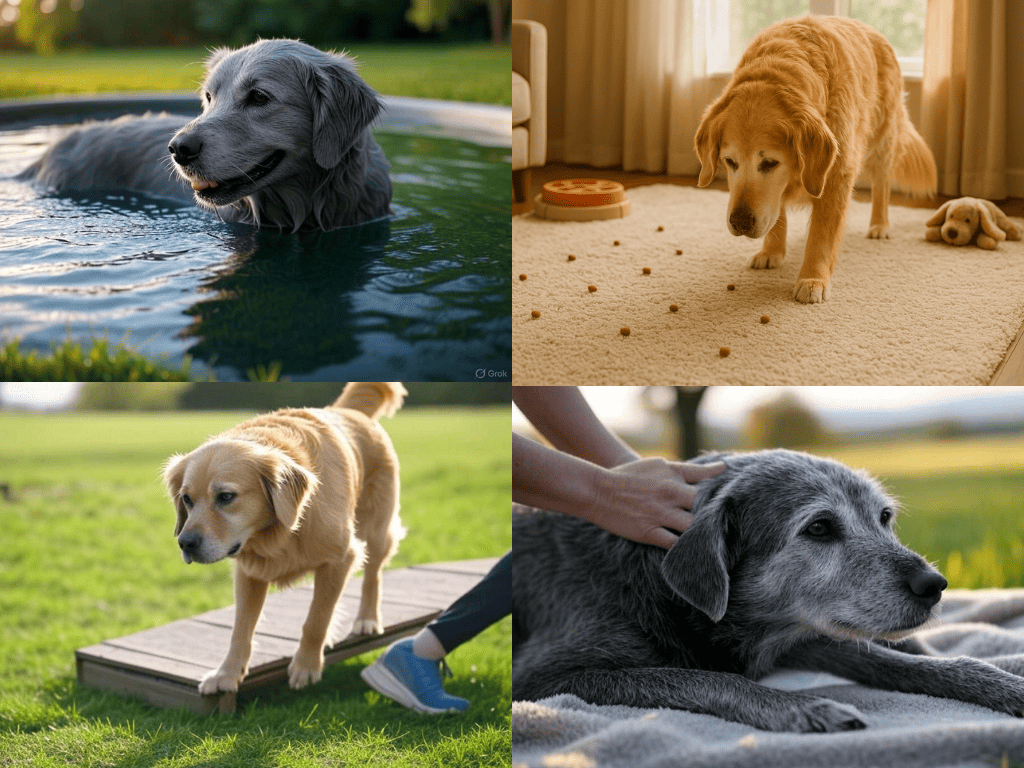Introduction
Arthritis is a prevalent condition in senior dogs, causing joint inflammation, pain, and stiffness that hinder mobility and daily activities. As cartilage wears down, flexibility decreases, making movements like standing or climbing stairs challenging. Gentle exercises for senior dogs with arthritis can enhance joint flexibility, reduce discomfort, and improve quality of life.
This article outlines five safe, effective exercises—short walks, guided stretching, supervised swimming, low obstacle courses, and therapeutic massage—to support your dog’s mobility and well-being. For complementary activities, explore our guide on fun and safe low-impact games for dogs with arthritis to keep your dog engaged and active.
How Arthritis Affects Flexibility
Arthritis erodes joint cartilage, leading to bone-on-bone contact that causes pain and restricts movement, particularly in weight-bearing joints like hips, knees, and elbows. Senior dogs often show:
- Symptoms: Difficulty standing, lying down, climbing stairs, limping, or avoiding activity.
- Consequences: Reduced flexibility worsens stiffness, limits mobility, and leads to muscle loss.
Maintaining joint flexibility through gentle, regular exercise is crucial. These activities lubricate joints, strengthen supporting muscles, and improve circulation, making movement more comfortable. Veterinary guidance ensures exercises are tailored to your dog’s condition, maximizing benefits and safety.
Benefits of Flexibility Exercises
Gentle exercises for senior dogs with arthritis offer physical and emotional advantages, supporting overall health.
- Reduced Stiffness: Regular movement keeps joints flexible, easing discomfort and improving posture.
- Improved Mobility: Enhanced range of motion makes daily tasks like walking or standing easier.
- Strengthened Muscles: Stronger muscles around joints provide stability, reducing strain and injury risk.
- Enhanced Well-Being: Exercise boosts endorphins, relieving stress and strengthening the human-dog bond.
These benefits help your dog stay active and happy, complementing broader exercise plans like those in our guide on the role of exercise in maintaining mobility.
Five Safe Exercises to Improve Flexibility
These vet-recommended exercises are designed to enhance flexibility while minimizing joint stress.
1. Short and Gentle Walks
Short walks promote joint lubrication and blood flow, reducing stiffness and supporting flexibility.
- How to Do It: Walk for 10–15 minutes, 2–3 times daily, at a relaxed pace with frequent breaks.
- Tips:
- Use soft surfaces like grass or carpet to cushion joints.
- Avoid steep hills or stairs to prevent strain.
- Monitor for fatigue or limping and adjust duration.
- Benefits: Improves mobility, provides mental stimulation, and fosters bonding.
2. Guided Stretching
Gentle stretching increases range of motion and reduces muscle tension, easing arthritis-related stiffness.
- Examples:
- Rear Leg Stretch: Support a hind leg and extend it backward slowly. Hold for 5 seconds, then release.
- Neck Stretch: Use a treat to guide your dog’s head up, down, and side to side for gentle stretching.
- Tips:
- Never force a stretch; stop if your dog shows discomfort.
- Perform daily in a calm setting to promote relaxation.
- Benefits: Enhances elasticity, improves circulation, and reduces pain.
3. Supervised Swimming
Swimming is a low-impact exercise where water’s buoyancy supports your dog’s weight, allowing free movement.
- How to Do It: Start in shallow, warm water (82–90°F or 28–32°C) with supervision and a life vest.
- Tips:
- Introduce water gradually for hesitant dogs.
- Limit sessions to 10–15 minutes to avoid fatigue.
- Benefits: Boosts flexibility, strengthens muscles, and improves circulation without joint stress.
4. Low Obstacle Courses
Gentle obstacle courses encourage controlled movement, improving coordination and flexibility.
- How to Do It: Set up soft, low obstacles like pillows or cones for your dog to walk around or step over.
- Tips:
- Guide slowly with treats or toys to maintain engagement.
- Adjust layouts to target different movements, keeping it fun.
- Benefits: Promotes natural joint motion, strengthens muscles, and stimulates mentally.
5. Therapeutic Massage
Massage reduces muscle tightness and boosts circulation, supporting joint flexibility and comfort.
- How to Do It: Use light, circular fingertip motions on shoulders, back, and thighs.
- Tips:
- Avoid strong pressure near sore joints.
- Perform after exercise when muscles are warm, ideally 2–3 times weekly.
- Benefits: Relieves tension, improves blood flow, and provides emotional relaxation.
These exercises, when done consistently, enhance your dog’s flexibility and mobility.
Safety Tips for Exercising
To ensure exercises for senior dogs with arthritis are safe and effective, follow these precautions:
- Monitor for Pain or Fatigue: Stop if your dog pants heavily, limps, or lies down suddenly. Consult a vet if discomfort persists.
- Use Safe Surfaces: Choose soft, non-slip surfaces like grass or rugs to prevent slips and reduce joint impact.
- Adjust as Needed: Adapt routines based on your dog’s changing needs, with veterinary input to ensure safety.
For more safety strategies, see our guide on how to safely adapt daily exercises for senior dogs.
Veterinary Guidance
Veterinary oversight is essential for a safe exercise routine.
- Assessment: A vet evaluates your dog’s arthritis severity and mobility to recommend suitable exercises.
- Therapy Options: Canine physical therapists may suggest massage, stretching, or hydrotherapy to complement home exercises.
- Regular Check-Ups: Ongoing evaluations adjust routines and incorporate treatments like supplements for optimal outcomes.
Veterinary support ensures your dog’s exercise plan is tailored and effective.
Frequently Asked Questions
How often should I exercise my arthritic dog?
Aim for 2–3 short sessions daily (10–15 minutes), adjusting based on your dog’s comfort. A vet can personalize the frequency.
Can I do these exercises indoors?
Yes, use non-slip mats for stretching or obstacle courses. Soft surfaces ensure safety in small spaces.
What if my dog resists exercise?
Try gentler activities or use treats to encourage participation. A vet can check for underlying pain causing reluctance.
Conclusion
Gentle exercises for senior dogs with arthritis, like short walks, stretching, swimming, obstacle courses, and massage, are powerful tools to improve flexibility and reduce joint pain. By supporting mobility and well-being, these activities enhance your dog’s quality of life. Work closely with your veterinarian, monitor your dog’s responses, and adapt routines to their needs. With care and patience, you can help your senior dog stay active, comfortable, and joyful. Share your dog’s progress in the comments!

